The History of Tudor Sailing Club by Kay Girard (Updated 2020)
Introduction
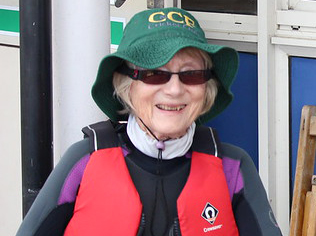
I (Kay Girard) have been a member of Tudor Sailing Club since 1984. In 1999 (the Club's 50th Anniversary), I wrote a potted history of the Club to enable new members to appreciate how it had been formed. Ten years on it seemed appropriate to bring it up to date in its 60th year and now having celebrated it's 70th anniversary I have noted further changes and development.
A big thank you to all those members who supplied photographs, magazines and anecdotes to the original document and this update. If any members past or present have more stories, or photos they would like to share, please email the the website administrator.
I hope you enjoy reading about the history of our wonderful sailing club.
In the beginning

Tudor Sailing Club began as a breakaway, splinter group of the Portsbridge Cruising Club. Six members wanted to participate in dinghy racing and were unable to persuade the Club to promote this. As a result they met in a private garage in Chatsworth Avenue and set about constructing Cadet dinghies which were designed for construction by amateur enthusiasts with little skill and little money. At the time there were six hundred boats being made throughout the country and they were being promoted through the magazine 'Yachting World'. The Second World War was over but there was still some rationing bringing austerity and drabness. A sail on the water seemed a touch of luxury reawakening dreams long forgotten.
Bits of wood, including pieces washed up by the sea, were used but still more was needed. It was necessary to apply to the Admiralty Regional Officer for a permit to buy sheets of marine plywood. A waterproof glue called Aerolite which had been used in the construction of the wooden Mosquito fighter-bomber aircraft of World War 2 fame, was used to stick the parts together. Scrap brazed with a blowlamp and using a few bricks to form a furnace made copper and brass fittings for rudders, chain plates, etc. Lucas and Company supplied the sails and a suitable mast could be made from two ex-Admiralty oars which were made from spruce. These were purchased from an ex-government surplus store and they were joined by a long scarf joint stuck together with glue.
On 19th January 1949 the Club became officially founded with General Rules being accepted. The entrance fee for sailing and social members was levied at two shillings and sixpence (twelve and a half new pence) per annum and sixpence (two and a half pence) a week extra for boat owners. Three pence per week of the boat owners' money was to go towards maintenance. The eventual aim was to have a Club house and storage space in the vicinity of Ports Creek. At this point in time the Club was in the embarrassing situation of being a sailing Club without any boats! Rumour was rife about a 'fleet taking to the water' but the first two dinghies weren't launched until 13th March 1949. By the end of April there were ten registered boats but only two afloat.
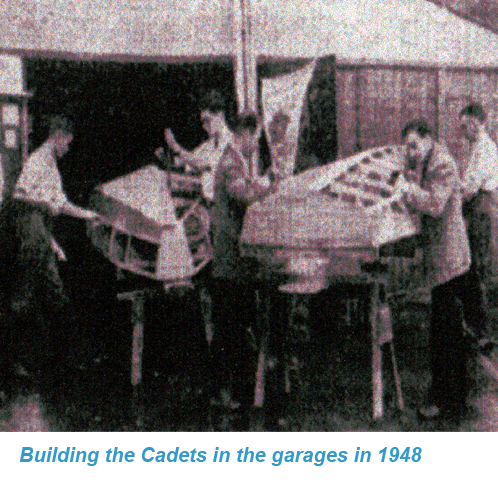
Initially a fleet of four Cadet dinghies was constructed and these were raced in Ports Creek. As reported earlier models were built mainly from scrap but by all accounts they sailed well and some are possibly still around today (they certainly were in 1999). The boats were launched from Tudor Crescent, when the tide obliged, and the Club became known as the Tudor Sailing Club. Club members pooled experience and tools and found what timber they could to add boats to the fleet. The following year another ten boats were built. Naturally even in those days a watering hole was sought which was Tudor Drill Hall in Tudor Crescent.
New members were attracted by the sailing display each week and joined the Club in droves. A maintenance party made sure the boats were kept in trim. The aim of the Club was to train members in seamanship and to promote interest in sailing and racing. One of the many who watched the first few Cadets sailing in the creek was Mr Harry Brickwood, boss of the brewery, and a keen yachtsman. He saw the advantage of teaching children to sail in the safe waters of the creek and gave encouragement to the enterprise by presenting the Brickwood trophy for competition amongst Clubs with Cadet fleets.

A social committee was formed in the first year of the Club's formation with the first function being a whist drive followed by a trip to Hayling Island. Tudor then made the national magazine 'Yachting World' when an article describing the Club and a photograph of a member's Cadet appeared. The city regatta was held in the summer with Tudor Sailing Club taking third and fourth places followed by Portchester Sailing Club's regatta where second, third and fifth places were achieved. Tudor's first regatta attracted an entry of forty eight craft.
In September 1949 a report was published in the Evening News about the Club activities and this stimulated further interest and increased membership. The first official Annual General Meeting was held in October 1949. The motto 'Unum consilium, unum ambitio, una propositum' or 'one design, one ambition, one purpose' was adopted. The highlight of the year in 1949 must have been the first Annual Dinner and Dance which was held at the Drayton Institute on 20th December 1949 where a toast was made to the King.
A growing club
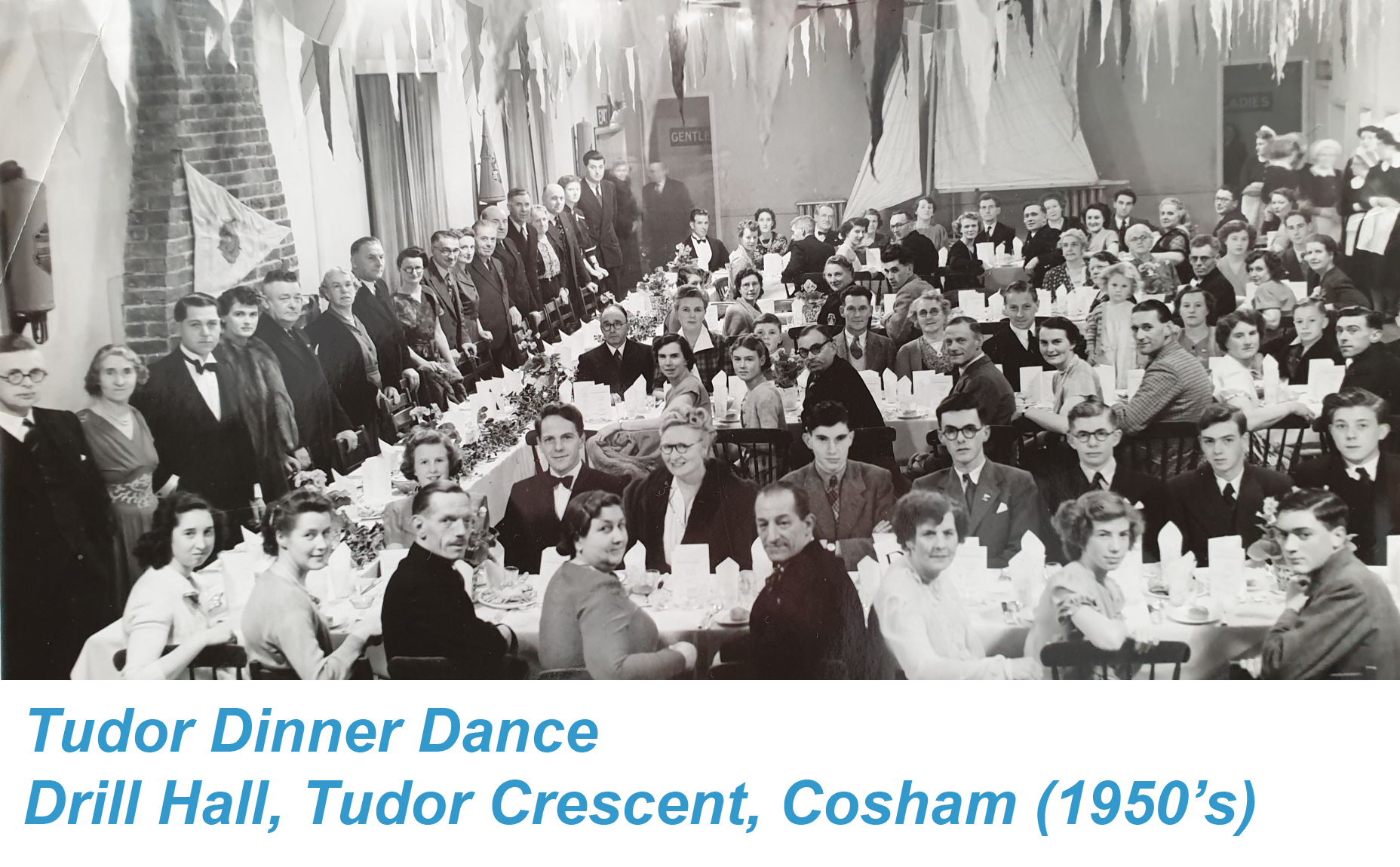
It became obvious in time that more extensive sailing waters were required for the improving Club sailors. Near Eastern Road bridge was an old rifle range blessed with a large 'hump' which proved a splendid grandstand and site for a flagstaff. One could look out across to Farlington Marshes and there was not a mooring in sight. It was ideal for dinghy racing. The Sailing Club's aim was to keep it that way and it wanted to ban all moorings in 'their waters'. A full racing programme was planned from April until the end of September.
The land for the first Club building was leased from Portsmouth City Council on a short term lease because Hampshire County Council had ideas of widening the Eastern Road. Members at that time regarded their little hump as idyllic. It was pure luxury when facilities became available in the form of an ex-service Nissan hut. A cup of tea could be brewed on a primus stove after the day's racing had finished but only if someone had remembered to transport the water from home! During the winter the hut was available for fitting out of boats under cover.
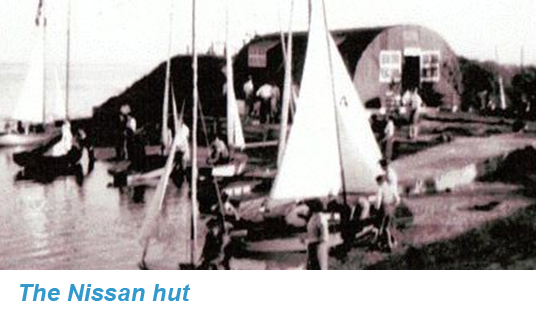
Following the success of the Cadet fleet a new senior class one was adopted - the Fleetwind. The Fleetwind designer had donated a jig so that every hull would be a strict one-design. The Fleetwind was stable, had a good performance and had modern refinements like a revolving mast and mast-jack. The cost was approximately £40 complete.
By 1951 there were 117 members and the Club had a full racing programme from April through to the end of September. There were 25-35 dinghies in the compound and 5 or 6 boats on moorings. The compound had started life as a deep ditch but this had been filled in and in a few years it had to be extended twice to accommodate the expansion of the Club. In addition two slipways were constructed by members to ease launching. Apart from Cadets which were usually sailed by adults with a child crew, there were Fleetwinds, Hornets and Enterprises. The 'one design' limitation had already disappeared.

Planning permission had been granted for the Nissan hut but no plans had to be submitted as it was assumed that everyone knew what a Nissan hut looked like. However it was soon outgrown and the cost of a new Clubhouse seemed prohibitive. As always the members pulled together to raise money. Programmes priced at 3d (just over 1p today) were sold for the first regatta in August 1951 and after three years in 1954 a weekly soccer results competition had raised enough money to build a new headquarters.
Waters were much more extensive around the old Club site than they are today. This was because major road works in the Portsbridge area had not yet started. The Club was going from strength to strength and all was going well until the idea of a bar in the new Clubhouse was raised. There was a certain amount of opposition from those who did not want the Tudor Sailing Club turned into a drinking Club but after vociferous argument the drinkers won. Gradually space was taken away from fitting out space in favour of the bar. Fitting out was eventually banished in favour of more social activities.
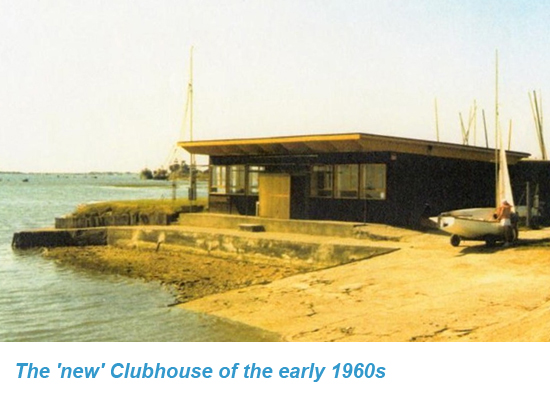
In 1958 planning permission was sought and agreed for a timber construction with windows and shutters added to the original building. A temporary portaloo was added for the ladies who, according to a past Commodore, invariably managed to 'bung' up clogging the pumping system. The Flag Officers had the dubious pleasure of unbunging it and transferring the contents into large bins to await the arrival of the Cleansing Department....unless of course the tide was in when they would trip clumsily and tip the lot over the sea wall! The men had the luxury of Elsons!
During these early years Tudor Sailing Club renewed its lease every five years. It was unable to secure any degree of lengthy tenure of the site, but then in 1972 worse was to come - the lease was required to be renewed annually.
The years of discussion and negotiation
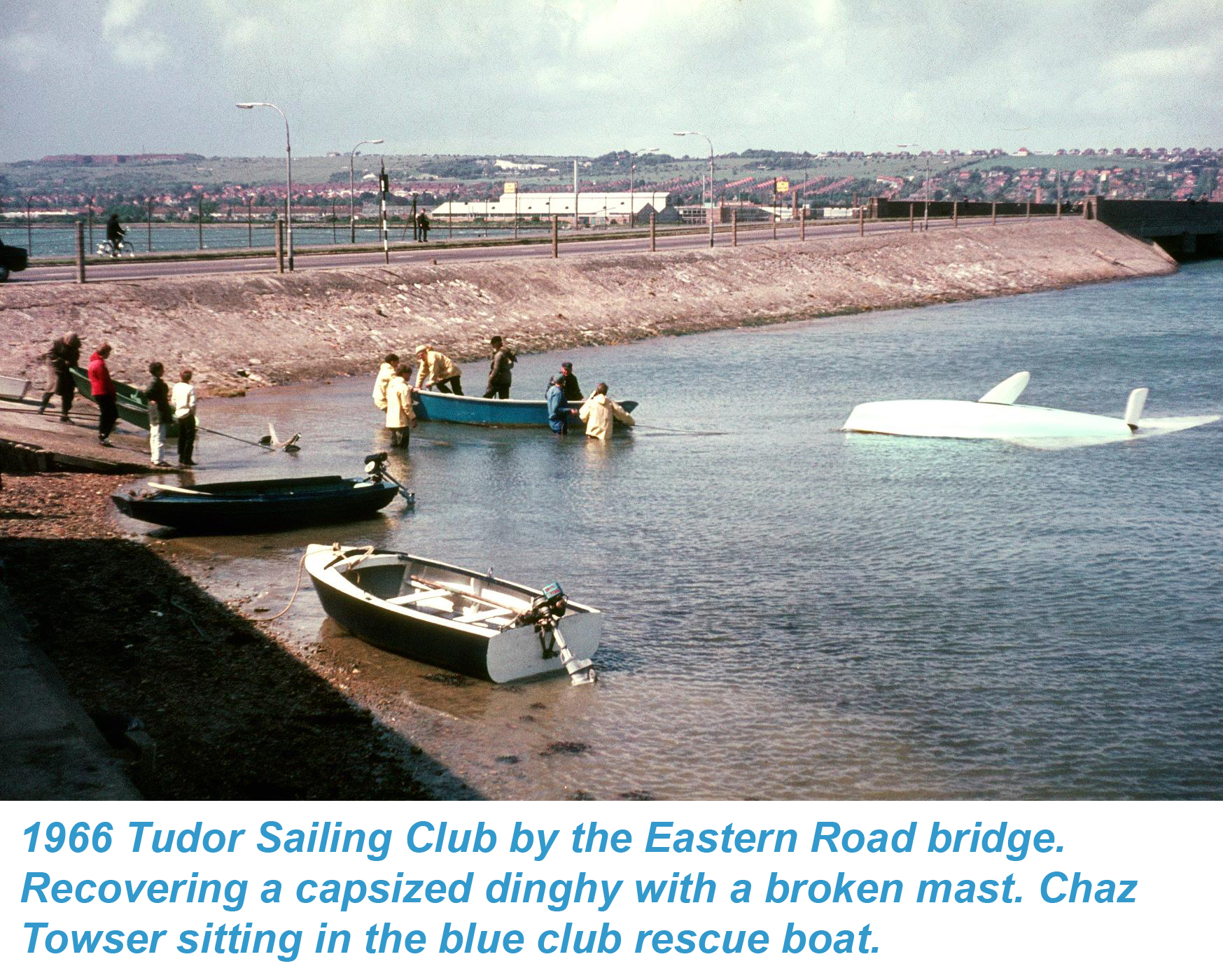
In the 70s and 80s there were many discussions regarding the growing needs of the Club and its location. Portsmouth Corporation supported the idea of TSC moving near the School's Sailing Centre because the Club buildings were an eyesore particularly where the toilet storage tanks were rusting through. The School's Sailing Centre and Eastern Road were then the responsibility of Hampshire County Council who were far more cautious and wary of any implications it may have on the School's Centre.
In 1970 TSC reported to the Portsmouth Planning Committee that they wanted an extension to the lease and to have some improvements made. A proposal was submitted for a new building to go at right angles to the original but this was refused because of the planned widening of the road, which at the very latest was going to happen by 1980.
During the years 1966 - 1978 at least 30 letters were exchanged and meetings took place between Club officials and Portsmouth City Council officials to come up with a site which satisfied both. TSC's preferred location was just south of Kendalls Quay. Club officials were concerned that they may be persuaded to take a site north of Kendalls which would have poor access to the water. A compromise might be to have a Clubhouse there and the boat compound by the slip south of Kendalls.
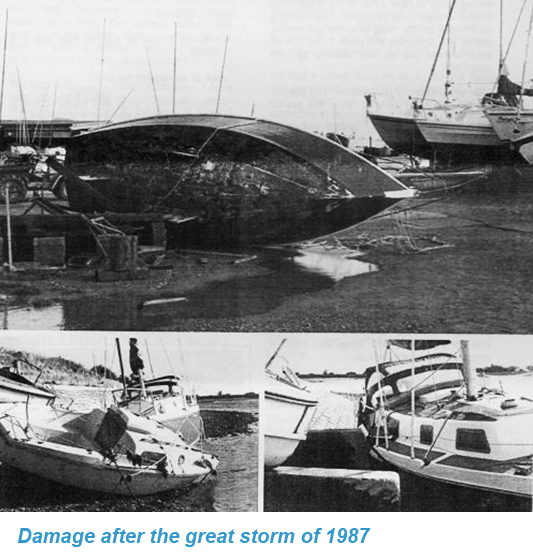
To cut a long and tedious story short, where hopes were raised and dashed, meetings with Hampshire County Council began in earnest and after four years of negotiation TSC accepted that if the shell of the building could be built on the land south of Kendalls then the membership would do the rest. On handover day in 1991 many were shocked at the enormity of what was being taken on. As a Club Tudor members had just recovered from the devastation of the 1987 storm with over 100mph winds and the repair or replacement of many boats had taken place.
New facilities at last
Due to the tremendous dedication and expertise of members the entire building and facilities were fitted out to a very high standard and a strong community spirit was forged. A wealth of talent was discovered amongst Club members - plasterers, plumbers, electricians all offered their services and those with not much talent but plenty of enthusiasm were happy to act as labourers. Every evening and weekend there was activity until all the work was finished. Three of the Flag officers who had seen the whole project through were awarded Honorary Life Membership in recognition of their dedicated work.
The weekend of the 'move' on the 4th and 5th of May 1991 there was a great deal of activity along the Eastern Road. Members with dinghies either transported their boats on trailers, trolley, car topped or sailed them round to their new home. The entire original site was cleared and over the years restored to the wild. Final touches were still being made to the new Clubhouse but these could be carried on with the premises open. Everyone was very impressed and excited by the wonderful facilities like central heating, hot water in the showers and the fitted kitchen. Care had been taken over design with hand crafted side light fittings resembling boats and the oak bar from the old premises reinstalled in the new.
Exciting new millennium approaches
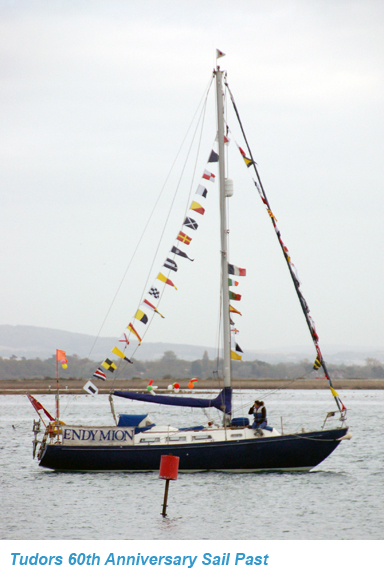
In 1999 Tudor's 50th anniversary was celebrated with special events and TSC opened its doors to the world with its own website being developed and launched. This was followed quickly by New Year celebrations in usual style with a disco, buffet and fireworks to mark the approach of the new Millennium.
In 2002 the Executive Committee approved a request by the 43rd Portsmouth Sea Scout group to share Club facilities. Although there was some opposition at first negotiations took place as the plan was thought to be mutually beneficial and would bring some new, young sailors into the Club. In the fullness of time, a number of Optimist dinghies came with the Scouts and have since been used by Tudor cadets. Another example of widening participation was in 2003 when Portsmouth University Sailing Club moved their boats into the compound and began racing.
Another improvement particularly for cruiser owners was the decision to purchase a tractor and hoist rather than having to book a contractor to lift out the cruisers and put them back in the water each year. This gave much more flexibility than was previously possible.
The 200th anniversary of the Battle of Trafalgar in 2005 saw Tudor boats participating in a Sea Carnival Procession in the Solent. The first Langstone Harbour Race Weekend for all the sailing clubs in the harbour was organised in 2009 over the May bank holiday weekend. This three day event was a new venture and proved to be very successful. Apart from competitive sailing during the day each club hosted a social event in the evening and on the final day there was prize giving. This successful format was the start of many happy annual events.
I can't help thinking what a long way Tudor has come since those early days! The Club now in 2011 has a membership in excess of 550, a full racing programme for dinghies and cruisers, a thriving Cadet section, a calendar of social events throughout the year including holidays abroad, social sailing in company, an informative magazine 'Ebb and Flow', an interactive website and much more. Let's face it; this couldn't happen without the hard work and commitment of its officers and membership. Long may it continue to offer so much to so many!
Widening participation
The next decade saw widening participation in water sports at the club as kayaks, canoes, surfboards and two gigs took to the water. Dinghies were donated or charity funded to provide a good fleet of suitable boats for both beginners and more advanced sailors which has been of huge benefit to the cadets in the club. Also it offered the opportunity to hire a dinghy and be able to explore our lovely harbour without the financial commitment of purchasing one. Another innovation has been Women on the Water held weekly during the summer months to encourage wider participation from women in all types of craft and is also a social event where I believe a lot of cake is consumed!
A full social calendar continues with quizzes, speakers, games evenings, Christmas Fairs, film nights, Summer Balls, annual prizegiving, special meals together and Friendly Fridays. On the sailing front the successful Langstone Harbour Race weekend continues as an annual event attracting dinghy sailors near and far. Our very first lady Commodore was elected in 2016 after over 60years of male dominance but it has to be remembered that the majority of sailors in the past were male.
There is constant change within a sailing club and with the new sea defences planned for 2020, the geography of the site will no doubt change. This may have an impact as will the Coronavirus outbreak of 2020 but Tudor members will pull together, do what is necessary and carry on enjoying the sport they love in an idyllic harbour and beyond.
